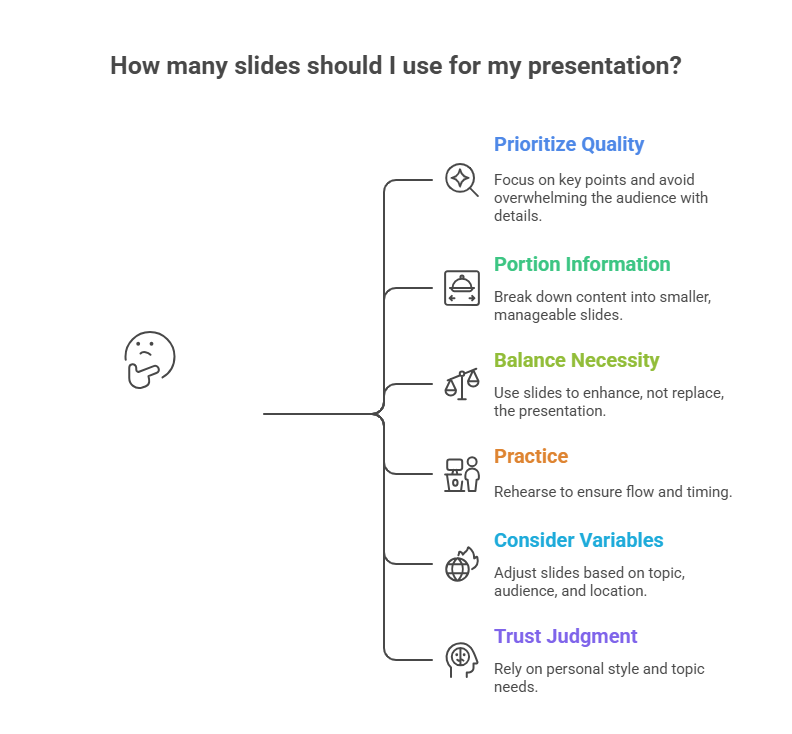Determining the ideal number of slides for a 20-minute presentation can be a challenge. It’s important to strike a balance between providing enough information and keeping your audience engaged.
While there is no one-size-fits-all answer, this blog post will explore some factors to consider when structuring your presentation. By understanding these factors, you can create a presentation that effectively conveys your message within the allotted time.
How Many Slides in a 20-Minute Presentation?
10 Slides in 20-Minute Presentaion
A popular guideline for 20-minute presentations is the 10/20/30 rule, introduced by Guy Kawasaki.
This rule suggests using 10 slides for your presentation, keeping it concise and focused. It also recommends a 20-minute time limit and a minimum font size of 30 points for easy readability.
This approach can be especially helpful for beginners or those who are less experienced in public speaking. While it’s a useful guideline, it’s important to remember that it’s not a strict rule and can be adjusted to fit your specific needs.
Strategies to Choose the Number of Slides for Your Presentation

1. Prioritize Quality Over Quantity
While it’s tempting to include a lot of detailed information in your presentation, too much can overwhelm your audience. Focus on your important points and avoid getting lost in too many details.
Remember, your slides should support your presentation, not replace it. If your slides are packed with text and data, your audience might end up reading instead of listening to you, which can make the presentation less engaging.
A well-designed slide should highlight the main ideas or complement them with visual or audio elements. Keep your slides clear, brief, and to the point, allowing the audience to focus on what you’re saying.
2. Portion Out Your Information
Think of your presentation like serving a good meal. Instead of delivering all the information at once, break it down into smaller, categorized portions.
This approach makes it easier for your audience to absorb and retain the information. If you have several important points, don’t cram them all onto one slide. Spread them out over multiple slides to emphasize each point individually and keep your audience’s attention focused.
For instance, if you’re discussing different products, dedicate a separate slide to each product rather than listing them all on one slide. This not only increases the number of slides but also enhances the impact of your message by giving each product the attention it deserves.
3. Balance Necessity and Simplicity
Efficiency is important when deciding how many slides to include. Your slides should enhance your presentation by providing visual support, guidelines, or additional information. However, avoid cluttering your slides with unnecessary text or images that don’t add value to your presentation.
Always consider the purpose of each slide element, like pictures or graphics, and eliminate anything that doesn’t serve a clear purpose. While some content might be fun or interesting, it’s important to assess whether it truly contributes to your message.
Also, remember that the more slides you have, the more structured your presentation becomes. This can be helpful if you’re nervous and need a clear guide, but if you prefer to speak more freely, fewer slides might give you the flexibility you need.
4. Make Practicing a Priority
Just like we encourage kids to practice what they’re unsure about, we should do the same for ourselves. A good way to see if your presentation flows well is to rehearse it at least once beforehand.
Practicing in front of friends or family can give you helpful feedback, but even practicing alone in front of a mirror or an imaginary audience can work. You’ll quickly notice where you might need adjustments, whether you have enough time, and if the slides fit well with your talk.
If your practice run finishes faster than expected, you can add more information and slides. On the other hand, if you struggle to stay within the allotted time and end up skipping slides or rushing through them, it’s time to make some cuts.
The pace at which you speak is important too. If you speak quickly, you might cover many slides in a short time. If you speak slowly, you’ll get through fewer slides. Ideally, your speaking pace should be comfortable for your audience and allow them to follow along easily. This also takes practice, but the goal is to present your slides at a pace that feels natural to you.
5. Consider the Variables
There’s no one-size-fits-all solution for the perfect presentation because many factors can influence it. The topic, audience, and location all play a role in determining how many slides you should use and how they should be structured.
6. Trust Your Own Judgment
There’s a lot of advice out there on how many slides are right for a presentation, but remember that these opinions don’t take your specific presentation style and topic into account. Recommendations vary widely, with some experts suggesting 40 slides for a 20-minute presentation and others recommending just two.
Ultimately, you’re the best judge of how many slides you need. This also applies to how much time you spend on each slide. Some slides might require more time, while others need only a few seconds. It all depends on the content and structure of each slide. It’s perfectly fine to spend several minutes on one slide and only a few seconds on another.
Closing Thoughts
In the end, the right number of slides for your 20-minute presentation depends on your content, style, and audience. Trust your instincts, keep your message clear, and remember that quality always outweighs quantity. With thoughtful preparation, you can deliver a presentation that resonates and engages.
Frequently Asked Questions
Is 20 slides too many for a 20-minute presentation?
Not necessarily. If the slides are simple and visual, 20 slides can work well. Ensure each slide focuses on one idea and avoid clutter.
How long should I spend on each slide?
Aim for 45–120 seconds per slide. Complex charts or diagrams may require more time, while simple visuals may only need a few seconds.
Should I use animations in a 20-minute presentation?
Use animations sparingly. Simple transitions are fine, but too many animations can distract the audience and slow down your pace.
What is the biggest mistake people make in presentations?
Overloading slides with text is the most common mistake. Keep slides minimal and let your verbal explanation carry the message.
Also read other informational posts:





